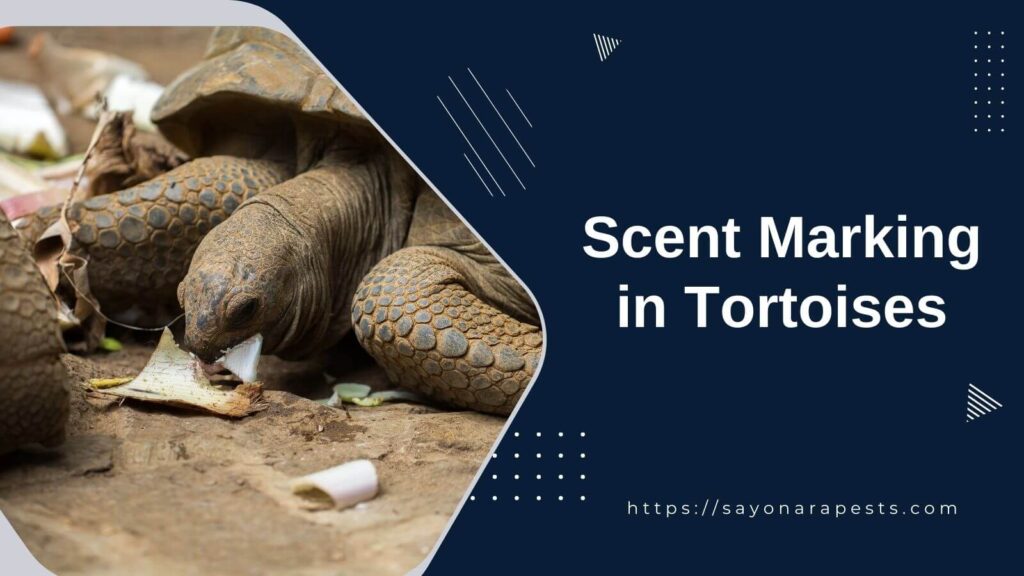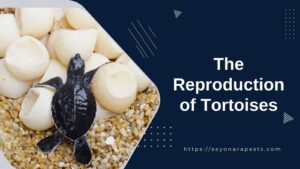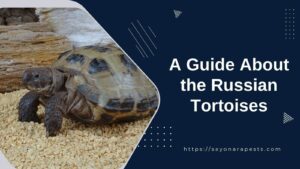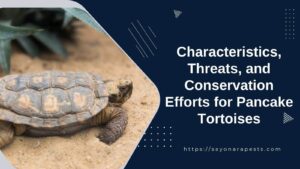In the complicated world of tortoises, scent marking stands out as a fascinating and complex behavior that deserves our attention. Scent marking is the deliberate use of smelly substances to send messages.
It is an important way for these mysterious creatures to talk to each other. It makes a fascinating tapestry of chemical signals that control how they interact with each other and how their society works.
In the world of tortoise society, smells are the most important language, and a good nose can learn a lot from them. Scent marking is more than just a pleasant way to enjoy the smell of a tortoise.
It shows how complex tortoise society is, which leaves researchers and fans alike in awe.
Tortoises have a small range of sounds they can make, so they have developed ways to communicate that don’t involve sound. One of the most important ways they do this is by leaving scent marks.
In the complicated dance of their lives, scent marking turns out to be a tool that tortoises can use to tell their own kind many different things.
Through the complex chemistry of smell, they can tell each other important things about their territory, their ability to reproduce, and even their own identities.
This smelly symphony is created by the interaction of volatile compounds, which leave a tapestry of scents on rocks, plants, and other surfaces that tells the story of their world.
Communication is at the heart of a tortoise’s life. It is a key part of how they stay alive and how they organize their social groups.
Tortoises are very solitary animals, so they use scent marking to set boundaries and mark their territory. This keeps them from having to fight directly with other tortoises.
They tell each other where they are and what they want to do by making a smelly mix of chemicals. This keeps conflicts to a minimum and makes sure that resources are shared well in their habitat.
Also, scent marking is an important part of courtship rituals. Males use pheromones in a planned way to attract potential mates and show that they are good partners.
The dance of smells becomes a lively language that helps tortoises get through the complicated social interactions that make up their lives.
Because scent marking in tortoises is so complicated and amazing, it’s clear that this olfactory symphony has a lot of depths of knowledge that haven’t been fully uncovered yet.
Because of how complicated it is, it makes researchers want to learn more about chemical communication and figure out what tortoises are trying to say.
As we learn more about this fascinating world, we find a lot of information that not only helps us understand how tortoises act but also shows us how their habitats work on a larger scale.
Tortoise’s scent marking is a great example of how many different ways animals have been found to talk to each other. It makes us wonder at the complexity of life and its many ways of expressing itself.
What is scent marking in tortoises?
The complicated world of scent marking in tortoises reveals a wide range of interesting behaviors that show how different animals use different ways to talk to each other.
When talking about tortoises, “scent marking” means that they put down smelly substances on purpose to send messages and connect with other tortoises.
It is a type of chemical signaling that is very important to how they get along with each other and how they stay alive.
Types of scent marking behaviors in tortoises
Urination
Tortoises use different kinds of scent marking to let others know they are there, that they own a certain area, that they are ready to have babies, and other important messages.
One of the most common ways is when tortoises urinate on rocks, plants, or other surfaces to mark their territory and leave a clear scent trail for other animals to follow.
This behavior not only marks the tortoise’s territory visually, but it also gives off chemicals that tell important things about the tortoise’s identity and where its territory ends.
Fecal marking
Tortoises also use their poop to mark their scent in a way that is easy to notice. They leave their poop in strategic places in their territories, often in high places or landmarks that are easy to find.
This lets them leave behind a strong combination of visual and olfactory clues that let potential invaders know they are there and where they live.
The smell of their poop is like a chemical signature that tells others about their status and where they are in the environment.
Rubbing of chin or cloaca on surfaces
In addition to peeing and pooping, tortoises rub their chins or cloacas on surfaces, which is an interesting behavior.
When tortoises rub their scent glands on rocks, logs, or plants, they leave behind scent marks that other tortoises can find.
This is especially common during the breeding season, when males may use scent marks to attract potential mates or show who is the boss in their social order.
How scent marking is used by tortoises in the wild
In the wild, scent marking is a key part of how tortoises interact with each other and defend their territory. It gives people a way to talk to each other and helps them set limits, avoid fights, and use their resources well.
Tortoises can learn a lot about the presence and identity of other tortoises, as well as their reproductive status and plans, by figuring out the complex language of smells.
Tortoises use scent marking as a way to navigate their complex social structure and make smart decisions about how to interact with other individuals.
Examples of scent-marking behavior in different species of tortoises
There are many kinds of tortoises, and they all have different ways of leaving scent marks. For example, during the breeding season, the African spurred tortoise (Centrochelys sulcata) uses a combination of urinating and rubbing its chin to attract mates and set up its territory.
The gopher tortoise (Gopherus polyphemus) is known for leaving feces near the entrances of its burrows as a visual and smelly signal to other tortoises.
The Galapagos giant tortoise (Chelonoidis nigra) has a complicated ritual of scent marking. They rub their cloaca on surfaces to let other animals know they are there and ready to reproduce.
These examples show the many different ways that tortoises leave scent marks and show how important chemical communication is in their lives. Tortoises’ social lives are made up of a complicated web of smells, sights, and displays of territory.
All of these things work together to make up this web. When scientists figure out how different species of tortoises mark their scents, they can learn more about their behavior, ecology, and the fascinating ways they use scents to get around in their world.
The Purpose of Scent Marking in Tortoises
How scent marking helps tortoises communicate with others of their species
Tortoises use scent marking as an important part of their communication, which is important for their survival, social interactions, and overall health. You can’t say enough about how important scent marking is for tortoises.
It helps them figure out how to get around in their complicated world and send different kinds of messages to other members of their species.
The different types of messages that can be conveyed through scent marking
Territoriality
At its core, scent marking is a way for tortoises to mark their territory and protect it. By putting smelly things in strategic places, they send a clear message to potential invaders about where their territory ends.
These scent marks show that the area has already been claimed and let other tortoises know that they shouldn’t go there.
This sense of territory is important for dividing up resources so that people can get food, water, and shelter without fighting.
Mating
Scent marking is a very important part of courtship and getting married. Male tortoises leave scent marks to attract potential mates and let them know they are ready to have babies.
The smells that animals leave behind when they urinate, mark their poop or rub their chins are strong pheromonal signals that tell other animals if they are good partners.
In turn, female tortoises can pick up on these signals and figure out what they mean. This lets them make smart decisions about potential mates and helps the species breed successfully.
Social hierarchies
The way tortoises mark their scent is also a big part of how they set up and keep their social order. People can show who is in charge or who is in charge of them through the complex language of smells.
This information makes it easier to set up a social order, which means that people don’t have to fight as much and are less likely to get hurt.
Tortoises can get along better with other animals and avoid unnecessary fights when they use scent markings to show how they feel about other people.
How scent marking may help tortoises avoid conflicts and reduce stress
One big benefit of scent marking for tortoises is that it might make them less likely to fight and be stressed out.
Tortoises can avoid direct confrontations and keep fights to a minimum by using scent marking to let other tortoises know what they want, where they live, and what their social status is.
This keeps people from getting hurt and saves energy and resources that would be wasted on fights that don’t need to happen.
Scent marking is a way for tortoises to talk to each other without fighting, which helps them live together peacefully and lowers their stress levels.
Tortoises leave scent marks for many reasons that are important for their survival and social lives. It helps them set up their territories, attract mates, show social order, and stop fights.
Scent marking can tell different things about territory, mating, and social status, among other things. This complicated way of talking is a big part of their lives. It helps them share resources well, have healthy babies, and live together peacefully.
By figuring out how tortoises mark their scent, we can learn a lot about their behavior, their environment, and the fascinating world of chemical communication among animals.
The chemical basis of scent marking in tortoises
Overview of the chemical compounds involved in scent marking
The way that tortoises communicate with each other through smell is based on a wide range of interesting chemical compounds.
Scent marking involves a wide range of volatile and non-volatile chemicals, each of which plays a different role in sending messages and getting responses from other members of the same species.
These chemical compounds combine to make a complex bouquet of smells that tortoises use to communicate with each other and understand their environment.
The role of pheromones in scent marking
Pheromones are a key part of scent marking because they help animals find each other. Pheromones are chemicals that an organism gives off that cause other members of the same species to act in a certain way.
During scent marking, pheromones are a very important way for tortoises to talk to each other. They can tell each other about their reproductive status, who owns the territory, and social cues.
Pheromones are strong chemical signals that can often be picked up at very low concentrations. This lets tortoises talk to each other well from far away.
How tortoises detect and interpret scent markings
Tortoises have an amazing ability to find and understand the complex scent markings that other tortoises leave behind.
Their sense of smell is very good, and they have special olfactory receptors that can tell if a chemical compound is there and what it is made of.
Tortoises can learn a lot about the identity, reproductive status, and territory boundaries of other individuals by figuring out how their smells are mixed.
Because they can smell so well, they can make smart choices about how to interact with others and use resources.
The impact of environmental factors on scent marking behavior and chemical composition
Several environmental factors can change the chemical makeup of scent marking and the compounds that are used. For example, temperature and humidity can change how volatile the chemical compounds are, which can change how long scent marks last and how easy they are to find.
The environment can also affect the availability of surfaces for scent marking, which can change how often and where scents are left behind.
Also, the presence of other odor sources, like predators or competing species, may change the intensity and composition of scent marking in tortoises, as they may need to change their ways of communicating.
Understanding the chemical basis of how tortoises mark their scent is a difficult and ongoing task.
Researchers try to find and describe the specific compounds involved, figure out what each one does, and figure out how the different chemical cues work together.
Scientists can learn more about how tortoises talk to each other and how they navigate their social and ecological environments by using scents by studying the chemicals that are involved in scent marking.
The chemical complexity of scent marking in tortoises shows how rich and complex their olfactory communication system is.
This intrigues both scientists and curious people who want to learn more about the fascinating world of chemical signaling.
Factors that influence scent marking behavior in tortoises
Age and sex differences in scent-marking behavior
Differences in age and sex play a big role in how animals mark their scent, and different patterns can be seen in different groups.
Young tortoises don’t mark their scent as often or as well as adults do because they are still learning about their social and reproductive roles.
When tortoises reach sexual maturity, they tend to mark their territory with a scent more often and more strongly, especially the males. This is because they are competing for mates and trying to show who is at the top of the social hierarchy.
These differences in age and gender show how complicated the relationship is between an individual’s growth and the need for social communication.
The impact of reproductive status on scent-marking behavior
Tortoises’ scent marking is also strongly affected by their ability to reproduce. During mating season, both males and females leave more scent marks to show that they are ready to reproduce and attract potential mates.
Males may use a combination of pheromones and visual markings to make their scent more noticeable and attract females.
On the other hand, females may leave scent marks to show that they are ready to mate or to turn away unwanted advances.
Tortoises mark their territory with scent because they are trying to get pregnant. This shows how important communication is for successful breeding.
The influence of social context on scent-marking behavior
Another important thing that affects how tortoises mark their scent is their social environment. Tortoises are not solitary animals; they have a social structure that affects how they talk to each other.
People of the same species often change how they mark their scents based on what they think is going on in their social environment. When tortoises are defending their territory, they may leave more scent marks when they find the scent marks of other tortoises nearby.
This serves as a visual and olfactory challenge. Also, the social order of a group of tortoises can affect how they mark their scent.
For example, dominant individuals often mark more often and more strongly to show their status and keep their place in the group.
The role of environmental factors on scent-marking behavior
Tortoises’ behavior of leaving scent marks is also heavily influenced by their environment. The frequency and location of scent deposition can be affected by things like rocks, plants, or specific landmarks that are good for scent marking.
Tortoises may change how they mark in response to changes in their environment, such as changes in the amount of food or the way their habitat is set up.
The intensity and composition of scent marking can be affected by environmental cues like temperature, humidity, and the presence of predators or competitors.
Tortoises may change their ways of communicating to improve their chances of survival and reproduction.
Tortoises leave scent marks in a complex way that depends on their age, gender, reproductive status, social situation, and environment.
Understanding these factors helps us learn more about how complex their communication systems are and how they are able to change their behavior.
By figuring out what makes tortoises mark their scent, scientists can learn more about how they interact with each other, how they reproduce, and how their environment works. This makes it possible to learn more about the fascinating world of these amazing animals.
The evolutionary significance of scent marking in tortoises
The way tortoises mark their scent has a big impact on their behavior and on their ability to stay alive and have babies. It also has a big impact on evolution.
Over millions of years, scent marking is likely to have changed into an adaptive strategy that helped tortoises talk to each other and share resources.
The role of scent marking in tortoise evolution
Tortoises are thought to have changed a lot over time because of how they leave scent marks. Scent marking helped set up and keep stable social hierarchies by marking territories and communicating social status.
This hierarchical organization may have had some benefits, such as less fighting and better use of resources.
People who were good at leaving scent marks would have had an easier time claiming territories, finding mates, and passing on their genes to future generations.
How scent marking behavior may have contributed to tortoise survival and reproductive success
Tortoises are likely to have been able to live longer and have more babies because of how they mark their scent.
Scent marking kept animals from fighting over territory and made sure that resources were used in the best way possible.
This, in turn, made people healthier and gave them more chances to have children. Also, scent marking helped animals find good mates by letting them know when they were ready to have babies, how good their genes were, and how healthy they were overall.
Males with strong scent-marking behaviors might have attracted more mates, which would have helped them have more offspring.
Meanwhile, females could use scent cues to show they were ready to mate and choose partners who smelled good.
Comparison of scent marking behavior in tortoises with other reptiles and mammals
Comparing how tortoises mark their scent to how other reptiles and mammals do gives us important information about how this way of communicating has changed over time.
Different kinds of animals all do this, but the specific behaviors and chemical compounds involved can be very different. Tortoises mark their scent in ways that set them apart from other reptiles and mammals.
These include urinating, leaving feces marks, and rubbing their chins. This suggests that tortoises mark their scent as a special adaptation to their ecological niche and the way they interact with each other.
Studying how different species’ scent marking is the same and how it is different can help us figure out how evolution and natural selection have shaped these ways of communicating.
Understanding how scent marking evolved in tortoises gives us a deeper understanding of their complex behavior and the adaptive value of their ways of communicating.
The way scent marking and tortoise evolution work together shows how important it is for social animals to be able to communicate well and sheds light on the amazing strategies that have helped tortoises survive for millions of years.
Researchers can learn a lot about the fascinating world of these ancient reptiles and the role of communication in their evolution by studying how scent marking evolved and how it affects a tortoise’s ability to stay alive and have babies.
The practical applications of studying scent marking in tortoises
Studying how tortoises mark their scent has real-world applications that go beyond basic research. It can help with conservation efforts, captive breeding programs, technological advances, and interdisciplinary fields, among other things.
How studying scent marking behavior can inform conservation efforts
Understanding how tortoises mark their scents can help protect and manage tortoise populations and improve conservation efforts.
By looking at how and where different species leave scent marks, scientists can learn a lot about how they use their habitats, where their territory lines are, and how their populations change over time.
This information can help shape conservation strategies by pointing out key areas that need to be protected, figuring out how the fragmentation of habitats affects animals, and giving information to reintroduction programs.
Scent marking behavior can be used to figure out how healthy a population is and how well conservation efforts are working.
The potential use of scent-marking behavior in captive breeding programs
The way tortoises mark their scent can also be used in programs to breed them in captivity. Keeping endangered species alive often depends on breeding them in captivity.
Knowing how tortoises leave scent marks can help breeding and reintroduction efforts succeed. By imitating natural scent-marking behaviors in captivity, researchers can create an environment that encourages sexual behavior and makes it easier for animals to have babies.
Also, scent marking can help animals choose mates and figure out how well they get along. This makes captive breeding programs more successful and increases genetic diversity.
The development of new technologies for studying tortoise scent-marking behavior
The study of how tortoises mark their scent could lead to the creation of new tools and methods for studying and keeping track of their behavior.
Technology improvements, like sensor-based monitoring systems and automated scent collection devices, can be used to record and analyze scent-marking behaviors in a way that doesn’t bother the animals.
Researchers can get high-resolution data on scent-marking patterns from these technologies. This lets them study tortoise behavior in detail and learn more about how they act.
Such improvements can help us learn a lot more about how scent marking works and get around the problems with traditional observational methods.
The potential applications of tortoise scent marking behavior in other fields, such as medicine or robotics
The ways that tortoises leave scent marks have uses outside of the field of biology. Tortoises have their own chemical compounds and ways of communicating that may be useful in other fields, like medicine or robotics.
Finding and analyzing the chemical compounds that tortoises use to mark their territory with scent could lead to the discovery of new compounds with healing properties.
Also, understanding how tortoises use smell to talk to each other could lead to the creation of robots that use chemical signals to do things like monitor the environment or find people in trouble.
In short, studying how tortoises mark their scent has real-world applications that go beyond basic research.
It can help with conservation efforts, guide programs to breed animals in captivity, speed up technological progress in monitoring and analysis, and maybe even spark new ideas in other fields.
By figuring out how tortoises mark their scent, scientists can make important contributions to the conservation and management of these amazing reptiles. They can also inspire collaborations and advances in many different fields.
Overall, scent marking is a key part of how tortoises communicate and interact with each other. It’s a sophisticated way for tortoises to talk about their territories, their ability to reproduce, and their place in the social order.
Tortoises create a complex olfactory landscape through their urination, feces marking and rubbing behaviors.
This helps them navigate their environment and communicate with other tortoises. Scent marking has been an important part of their evolution for millions of years, helping them stay alive and have successful offspring.
Even though we have learned a lot about how tortoises mark their scent, there is still a lot more to find out.
More research is needed to learn more about the chemicals that make up scent marks, to figure out what different scent cues mean, and to find out what makes different tortoise species do what they do when they leave scent marks.
New technologies, like sensor-based monitoring systems and automated data collection methods, can help us learn more about how scent marking works and give us important information about how tortoises act.
The interesting way that tortoises talk to each other through scent marking shows how rich and complicated their social lives are. Their ability to find, understand, and respond to chemical clues left by other members of their species shows how complex their communication systems are.
As we learn more about how tortoises mark their scent, we learn more about the different strategies that these ancient reptiles have developed over time.
The study of scent marking not only helps us learn more about tortoises but also helps us learn more about how animals communicate and the amazing ways that different species navigate their social and ecological environments.
In the end, scent marking is an important and interesting part of how tortoises act. It is an important part of their evolutionary history, their strategies for staying alive, and their ability to have children.
You can’t say enough about how important it is for tortoises to leave scent marks, because it affects how they interact with each other and helps them find their way around. But there is still a lot to find out and learn about in this field.
More research is needed to figure out how tortoises mark their scent and what that means for their conservation, management, and understanding of how animals talk in general.
The study of how tortoises mark their scent will continue to fascinate scientists because it gives them exciting insights into the secret language of these amazing reptiles.





